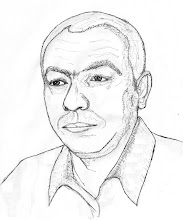luni, 26 martie 2012
Voices from the Collective: Emory Douglas Roasts Pork
There was more to the Black Panther Party than traditional dignity in resistance. There was also its sense of style, from the elegant to the outrageous.
Mike Mosher
Issue #67, April 2004
In her essay The Revolution Will Be Visualized: Emory Douglas in The Black Panther artist/designer Colette Gaiter celebrates an important American political graphic artist. Her essay is the aesthetic and contextualizing appreciation that Emory Douglas' work thirty-some years ago deserves, citing his influences and motifs and placing him in art history. The essay showcases forceful posters, including photo collage work reminiscent of Romare Bearden, and expressive drawings of righteously indignant black women and oppression-resistant families. Though angrier, the artwork has a dignity that now seems a continuation of the earlier church-based Civil Rights movement. Yet there was more to the Black Panther Party than traditional dignity in resistance. There was also its sense of style, from the elegant to the outrageous.
In its choice of an animal name, its fashion sense and the public display of guns, the BPP had an agressively provocative visual style. Perhaps its style was more deliberately upsetting than the Party's primary activities — legal actions, neighborhood programs and voter registration — might have deserved. This reader misses a significant part of Douglas' visual contribution to the Panther aesthetic in Gaiter's otherwise attentive paper. For as an Emory Douglas fan since adolescence, I can't help but ask: Where are the pigs?
Famous for his many porcine cartoon policemen, Douglas discussed his pigs when he lectured during a 1995 exhibition at S.F.State, and speaks of pig symbolism in an interview, so he hasn't disowned those images. There is some suggestion of Douglas' comic stylization of the troops of oppression in the "Shoot to Kill" graphic Gaiter provides. To any inner-city neighborhood resident constantly hassled (at worst, beaten or shot) by sweaty, overweight Caucasian men with bellies rolling over their uniform belts, the police grotesquely represented as swine must've been bitterly, hilariously apt. They are drawn as repulsive as the complacent bourgeoisie of 1920s Berlin beneath the pen of George Grosz, as they should be.
The breadth of Douglas' work for The Black Panther newspaper might be suggested in comparison to other, later East Bay leftist postermakers. Inkworks carries on traditon of his stately political posters, the aspect of Douglas' work well-represented in Gaiter's essay. In depictions of corporate and military criminals, Doug Minkler continues the jagged Punk strain of Douglas' pigs, which the essay omits. Douglas took Black Panther readers in both of those visual directions, the well-rendered and the outlandish, directions seemingly contradictory but chosen appropriately to carry the content and message of the artwork.
In his pig-headed policemen, we remember that Douglas was a Bay Area contemporary of Robert Crumb, the ZAP Comix artists, and Dan O'Neill's sexual and politicized appropriated Disney characters. One might assume the artist's familiarity with bloodthirsty tales by S. Clay Wilson, whom Douglas' cartoons of vengeance upon snout-nosed cops probably influenced in turn.
Outrageous caricature and comics have a place in progressive activism, so any overview of Emory Douglas must not be restricted only to his "realistic" work. Let us celebrate, along with his more traditional communication design skills and political passion, that which was funny and over-the-top from Emory Douglas. You can't have 1968 Oakland without the oink.
Bad Subject Mike Mosher discussed political graphics in Eye Candy Like a Raised Fist: Graphics For Political Words, which appeared in Bad Subjects #27.
http://bad.eserver.org/issues/2004/67/mosher.html
Abonați-vă la:
Postare comentarii (Atom)


Niciun comentariu:
Trimiteți un comentariu